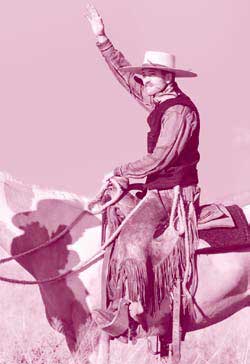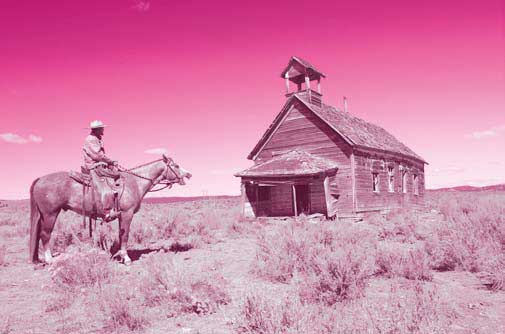




西部牛仔 |

|
对大多数美国人和世界上许多人来说,美国西部牛仔是具有英雄主义和神秘色彩的人物。由于迭出不穷的西方电影以及各种平装小说和电视节目的渲染,使得善良、干练、勇敢的西部牛仔备受欢迎。事实上,西部牛仔是一种短暂的历史现象,是美国西部从1866年到1886年这段时期盛极一时的一种服务行业的工人。


|
Reading in a single sitting
|
A cowboy is an animal herder who tends cattle on ranches in North America, traditionally on horseback, and often performs a multitude of other ranch-related tasks. The historic American cowboy of the late 19th century arose from the vaquero traditions of northern Mexico and became a figure of special significance and legend. A subtype, called a wrangler, specifically tends the horses used to work cattle. In addition to ranch work, some cowboys work for or participate in rodeos . Cowgirls, first defined as such in the late 19th century, had a less-well documented historical role, but in the modern world have established the ability to work at virtually identical tasks and obtained considerable respect for their achievements.
As English-speaking traders and settlers expanded westward, English and Spanish traditions, language and culture merged to some degree. American traders along what later became known as the Santa Fe Trail(圣菲小道,1821-1880年美国新墨西哥州圣菲城和密苏里州之间的一条很重要的贸易通道)had similar contacts with vaquero life. Starting with these early encounters, the lifestyle and language of the vaquero began a transformation which merged with English cultural traditions and produced what became known in American culture as the "cowboy".
The arrival of English-speaking settlers in Texas began in 1821, while California did not see a large influx of settlers from the United States until after the Mexican-American War. However, in slightly different ways, both areas contributed to the evolution of the iconic American cowboy. Particularly with the arrival of railroads, and an increased demand for beef in the wake of the American Civil War, older traditions combined with the need to drive cattle from the ranches where they were raised to the nearest railheads, often hundreds of miles away.
By the 1880 s, the expansion of the cattle industry resulted in a need for additional open range. Thus many ranchers expanded into the northwest, where there were still large tracts of unsettled grassland. Texas cattle were herded north, into the Rocky Mountain(落基山)west and the Dakotas(达科他州). The cowboy adapted much of his gear to the colder conditions, and westward movement of the industry also led to intermingling of regional traditions from California to Texas, often with the cowboy taking the most useful elements of each.

The cowboy has deep historic roots tracing back to Spain and the earliest European settlers of the Americas. Over the centuries, differences in terrain , climate and the influence of cattle-handling traditions from multiple cultures created several distinct styles of equipment, clothing and animal handling. As the ever-practical cowboy adapted to the modern world, the cowboy' s equipment and techniques also adapted to some degree, though many classic traditions are still preserved today.
Barbed wire, an innovation of the 1880 s, allowed cattle to be confined to designated areas to prevent overgrazing of the range. In Texas and surrounding areas, increased population required ranchers to fence off their individual lands. In the north, overgrazing stressed the open range, leading to insufficient winter forage for the cattle and starvation, particularly during the harsh winter of 1886-1887, when hundreds of thousands of cattle died across the Northwest, leading to collapse of the cattle industry. By the 1890 s, barbed wire fencing was also standard in the northern plains, railroads had expanded to cover most of the nation, and meat packing plants were built closer to major ranching areas, making long cattle drives from Texas to the railheads in Kansas unnecessary. Hence, the age of the open range was gone and large cattle drives were over. Smaller cattle drives continued at least into the 1940 s, as ranchers, prior to the development of the modern cattle truck, still needed to herd cattle to local railheads for transport to stockyards and packing plants. Meanwhile, ranches multiplied all over the developing West, keeping cowboy employment high, if still low-paid, but also somewhat more settled.
牛仔长途赶运牛群如同大规模的行军。押送特大牛群的牛仔们要严格分工,各司其职。现存的一些照片显示,他们的生活既艰苦又肮脏,工作却不像一般想象的那样危险。牛仔的生活方式到了19世纪80年代中叶宣告结束。当时美国土地有40%是用于畜牧的。市场上的牛肉大大供过于求,以至价格大跌,许多牧场主破产。19世纪末,美国的交通运输日益发达,牛仔的地位渐渐降低。1886年冬天的一场大风暴毁灭了数以百万计的牛,使许多牧场主和牧群陷入绝境。牧场主们从这双重灾难中复苏过来后,他们安装了铁丝网栅栏,以便在比较容易控制的条件下管理和喂养牛群。从此,再也无须在空旷的牧场上放牧了。
herder 牧人
ranch 大农场
vaquero 放牛者
rodeo 竞技
merge 融合
influx 流入,汇集
contribute 贡献
intermingle 混合
terrain 地形
barbed 带刺的
overgraze 过度放牧
forage 饲料

|
Key Words in History
|
Lariat; from the Spanish "la riata," meaning "the rope," sometimes called a lasso, especially in the East, or simply, a "rope". This is a tightly twisted stiff rope, originally of rawhide or leather, now often of nylon, made with a small loop at one end called a "hondo." When the rope is run through the hondo, it creates a loop that slides easily, tightens quickly and can be thrown to catch animals.
Spurs; metal devices attached to the heel of the boot, featuring a small metal shank, usually with a small serrated wheel attached, used to allow the rider to provide a stronger (or sometimes, more precise) leg cue to the horse.
Modern cowboys often have access to a rifle, used to protect the livestock from predation by wild animals, more often carried inside a pickup truck than on horseback, though rifle scabbards are manufactured, and allow a rifle to be carried on a saddle. A pistol is more often carried when on horseback. The modern ranch hand often uses a .22 caliber "varmit" rifle for modern ranch hazards, such as rattlesnakes, coyotes, and rabid skunks. In areas near wilderness, a ranch cowboy may carry a higher-caliber rifle to fend off larger predators such as mountain lions. In contrast, the cowboy of the 1880s usually carried a heavy caliber revolver such as the single action .44-40 or .45 Colt Peacemaker (the civilian version of the 1872 Single Action Army). The working cowboy of the 1880s rarely carried a long arm, as they could get in the way when working cattle, plus they added extra weight. However, many cowboys owned rifles, and often used them for market hunting in the off season. Though many models were used, Cowboys who were part-time market hunters preferred rifles that could take the widely available .45-70 "Government" ammunition, such as certain Sharps, Remington, Springfield models, as well as the Winchester 1876.

The cowboy hat is a high-crowned, wide-brimmed hat best known as the defining piece of attire for the North American cowboy. Today it is worn by many people, and is particularly associated with ranch workers in the western and southern United States, western Canada and northern Mexico, with country-western singers, and for participants in the North American rodeo circuit. It is recognized around the world as part of Old West cowboy lore. The shape of a cowboy hat' s crown and brim are often modified by the wearer for fashion and to protect against weather.

|
Background Knowledge
|
美国人是欧洲移民的后裔,美国的牛则是欧洲的后代。美国的牛最早是由哥伦布带去的。当时,他把西班牙牛带到西印度群岛和中、南美洲沿海一带。1540年,西班牙探险家科罗纳多横渡大西洋去北美寻找传说中的“瑟博拉七宝城”,他还带了500头牛,这些牛被运到今天墨西哥北部和美国的亚利桑那州一带。此后,牛群不断繁殖,逐渐遍布今墨西哥北部和哈利斯科州。到17世纪初,哈利斯科的牛已达到10万多头。
总之,美国的牛从东面和南面两个方向进入,逐渐遍布全国。18世纪初,牛群出现在美国的俄亥俄州和肯塔基州。肯塔基被印第安人称为青草州。伊利诺伊州则被印第安人称为“草原之国”,这里是牛的乐园。到19世纪中期,那里驯牛养牛的技术已经十分高明。南北战争之后,牛群又向西推进到密西西比河以西的广大草原,那里成了“牧牛王国”。从南边墨西哥进入的西班牙牛也大量繁殖,从19世纪60年代开始,德克萨斯人便把大量牛群往北驱赶到堪萨斯的铁路边,然后转销美国各地。当时还有专门的“牛道”和“牛镇”,“牛道”是“牛群”走的道路,“牛镇”则是沿途的歇脚站。
在19世纪60年代,紧接着美国南北战争之后,火车冷藏车厢的发明,使得牛肉能够长途运输而保持新鲜。结果,美国东部各大城市的市场都向西部大牧场主开放,而大牧场主们立刻以扩充牧群饲养规模来适应日益增加的需求量。在德克萨斯州和西南部各州大牧场饲养的牛群都要集中赶到当时美国最靠西部的火车终站,即设在堪萨斯州阿比林的火车终站。从那里,用棚车把牛运至芝加哥,经屠宰、切割和冷冻后再运往东部。牛群长途跋涉,跨州越县,当然需要人带领、照管,数以千计的年轻人蜂拥而至,要在大牧场寻找工作。他们是中西部农场的小伙子,寻求冒险的英国人,东部想脱离父母独立的年轻人,以前叛变的士兵,少数原是奴隶的黑人,一些印第安人,以及来自边境的墨西哥人。他们,就是西部牛仔的最初群体来源,后被人们称为“马背上的英雄”。
如果说西部牛仔体现出来的西部精神构成了美国精神的雏形的话,那么西部小说中牛仔形象的出现,则使美国精神得以定型,成为了美国精神的象征。